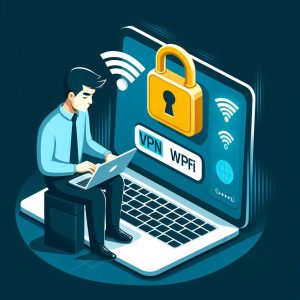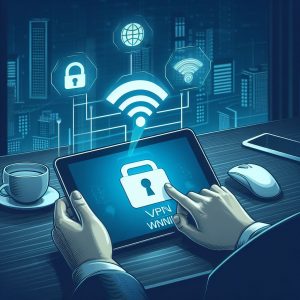Introduction
A virtual private network (VPN) has become an essential tool for protecting one’s privacy and security when using the internet. As more people rely on public WiFi networks, using a VPN is critical to keep browsing activities private. But how exactly does a VPN work on WiFi networks? Can it be fully effective if connected through public hotspots? This article will provide an in-depth explanation of how VPNs function on WiFi, discuss using the Outline VPN service specifically, common issues that arise, and solutions to ensure a smooth, secure connection.
Definition of VPN
A virtual private network, commonly abbreviated as VPN, is a service that encrypts internet traffic and routes it through an intermediary server in a remote location. This creates an encrypted tunnel between a user’s device and the VPN server. The user’s traffic enters the tunnel from one end, reaches the VPN server at the other end, and exits to the public internet from there.
The encryption prevents third parties like internet service providers (ISPs), hackers, or governments from being able to view the contents of the traffic as it flows from the user’s device to the websites and services they are accessing. This allows people to browse the web privately and access restricted content anonymously via the VPN.
Importance of VPN
There are several important reasons why people use VPN services today:
- To access geo-restricted content – Many online streaming services have licensing restrictions that limit content availability based on geographical locations. A VPN allows people to bypass these restrictions.
- Public WiFi security – Using public hotspots carries the risk of man-in-the-middle attacks that can steal login credentials and other sensitive data. Connecting via a VPN while on public WiFi encrypts all traffic to stay secure.
- Privacy protection – VPN services do not log user activity, allowing people to keep their browsing histories private from ISPs and advertisers. This prevents tracking and profiling.
- Censorship circumvention – In countries that restrict access to parts of the internet, people can use VPNs to bypass censorship and access banned websites and apps.
As more people work remotely today, using public hotspots to connect to the internet, having a way to securely traverse WiFi networks has become critical. That is where understanding how VPNs function on WiFi is important.

How VPN Works on WiFi
To understand how effective a VPN can be when connecting through WiFi, it is essential to first comprehend how VPN encryption works in general.
Explanation of How VPN Works
Without a VPN, internet traffic from a WiFi-connected device is transmitted directly to websites and services on the public internet. This makes it possible for third parties to intercept and view that traffic.
A VPN app on the device connects to a remote VPN server run by a VPN provider. This establishes an encrypted tunnel from the device to that server. Any traffic leaving the device is first routed through the VPN tunnel before exiting to the public internet.
The traffic is encrypted using protocols like Internet Protocol Security (IPSec) or Secure Sockets Layer (SSL). This means the contents cannot be deciphered by hackers or other third parties that may capture the data packets.
The traffic exits from the VPN provider’s server. Websites and services therefore receive the traffic from the VPN server’s IP address, not the user’s real IP address. This allows for anonymity while browsing.
Only the VPN provider can match the traffic back to the user’s device due to having access to the encryption keys, login credentials, and internal logs. Reputable services do not monitor user activity or keep extensive logs.
How VPN Works on WiFi
When connecting to public WiFi at a coffee shop, airport, hotel, or elsewhere, the device joins a network controlled by that establishment. While convenient, this carries security risks.
All traffic on public hotspots traverses the local network before reaching the wider internet. An attacker could position themselves within this network to capture traffic utilizing tricks like ARP spoofing or DNS hijacking.
By running a VPN app, the device has an encrypted tunnel that contains any traffic leaving it before reaching the untrusted public WiFi network itself. So the VPN protection is applied first before anything interacts with the hotspot.
This makes it near impossible for other users on the same network to intercept or view the contents of traffic headed to the VPN server. Even the WiFi operator would only see indecipherable encrypted data.
The VPN tunnel persists through to the server on the other end, which could be a country away, before data exits to its final destination. This gives users privacy and anonymity while on public networks.

III. Using Outline VPN
Outline VPN is one of several services that uses VPN technology to help protect users on public WiFi. Here is an overview of Outline, how it functions, and some troubleshooting tips.
Overview of Outline VPN
Outline VPN was created by Jigsaw, an incubator that is part of Google’s parent company Alphabet. The software-defined network provides users a free and easy way to encrypt traffic and mask their IP addresses.
Outline runs a global network of private servers that users can connect to via desktop and mobile apps. The app then routes all device traffic through an encrypted tunnel to the server before exiting to the open internet.
This works the same way on both WiFi and cellular connections. Unique to Outline is that anyone can also deploy their own Outline servers for others to use. This has helped the service grow quickly.
Outline relies on the Shadowsocks protocol rather than more common solutions like OpenVPN or IPSec. Shadowsocks uses 256-bit encryption and works at the transport layer to authenticate and encapsulate traffic.
How to Connect to Outline Server
Using Outline VPN on a phone, tablet, or computer takes just a few steps:
- Download the Outline client app for the relevant desktop or mobile platform from the official website. The mobile apps are also on the iOS and Android app stores.
- Open the app and select ‘Get Started’. This will bring up the server list. By default, it recommends the fastest and most reliable options.
- Tap on the server of choice and select ‘Connect’. This will establish the encrypted Shadowsocks tunnel.
- The app will display connection status. Once successful, internet traffic will now funnel through the tunnel to that server. The IP address visible to websites will mask the user’s real public address.
Troubleshooting Connection Issues
Sometimes VPN connections can unexpectedly drop or have trouble establishing a tunnel initially. Issues with Outline VPN could arise from:
- Server overload – Popular servers see high demand. Trying another option may work.
- Local network conflicts – Resetting WiFi routers or toggling airplane mode can clear conflicts.
- Software bugs – Updating apps and rebooting devices generally helps resolve software glitches.
- Regional blocking – Some countries actively block VPN traffic. Different protocols like WireGuard may be better suited.
- Client misconfigurations – Deleting and reinstalling apps often fixes inconsistencies causing failed handshakes.
Getting in touch with Outline’s customer support can also help diagnose difficult connectivity problems.
Issues with VPN on WiFi
While connecting to public WiFi hotspots through a VPN keeps online activity secure, users may still experience periodic issues that disrupt seamless usage. Understanding why problems crop up and how to address them is valuable for staying protected.
Common Issues with VPN on WiFi
Using a VPN over WiFi networks can pose challenges around speed, stability, and privacy:
- Reduced internet speeds – Routing traffic through distant VPN servers causes latency and bandwidth bottlenecks that downgrade connectivity speeds.
- Connection reliability – Changing WiFi networks as people move about can cause VPN disconnections. Public hotspots themselves also experience outages at times.
- DNS and IP leaks – Software bugs or configuration errors can allow DNS requests and device IP addresses to bypass the VPN tunnel and transmit externally in plain text.
- Inconsistent encryption – Weak WiFi security protocols like WEP open holes that either break or downgrade VPN encryption strength.
Solutions to VPN Issues on WiFi
Here are ways to troubleshoot and remedy some of the common VPN problems that tend to appear more often when users are connecting via WiFi hotspots:
- Quickly switching between servers on the VPN app can help alleviate speed issues caused by distant locations or overloaded access points.
- Enabling ‘Auto-Reconnect’ on VPN clients will quickly restore dropped connections – both the hotspot and VPN link – without much downtime.
- Leak testing sites can detect DNS or IP leaks. Changing security settings on VPN apps typically address them.
For weak WiFi encryption, using a software or hardware-based WiFi Protected Access 3 (WPA3) client can bolster transmission protection.
Conclusion
Virtual private networks have become essential for securing WiFi traffic as hotspot usage continues to increase globally. Understanding how VPN encryption interacts directly with public networks sheds light on its effectiveness for privacy and circumvention. While periodic speed or stability issues still arise, troubleshooting and configuring clients properly keeps problems at bay.
For those looking for a capable VPN solution to stay safe on the go, Outline VPN provides an accessible way to traverse WiFi safely. As with any VPN provider, fully trusting the platform requires carefully vetting its privacy policies around activity logging and user identity protection. Outline’s association with Google via Jigsaw is either reassuring or concerning depending on one’s views regarding big tech and data stewardship.
Ultimately, the threats posed by unprotected public WiFi access necessitate utilizing a VPN whenever connecting digitally in public spaces. Taking the time to research providers, implement secure configurations, and rectify connectivity issues pays dividends for long term safety and privacy while traversing wireless networks.
